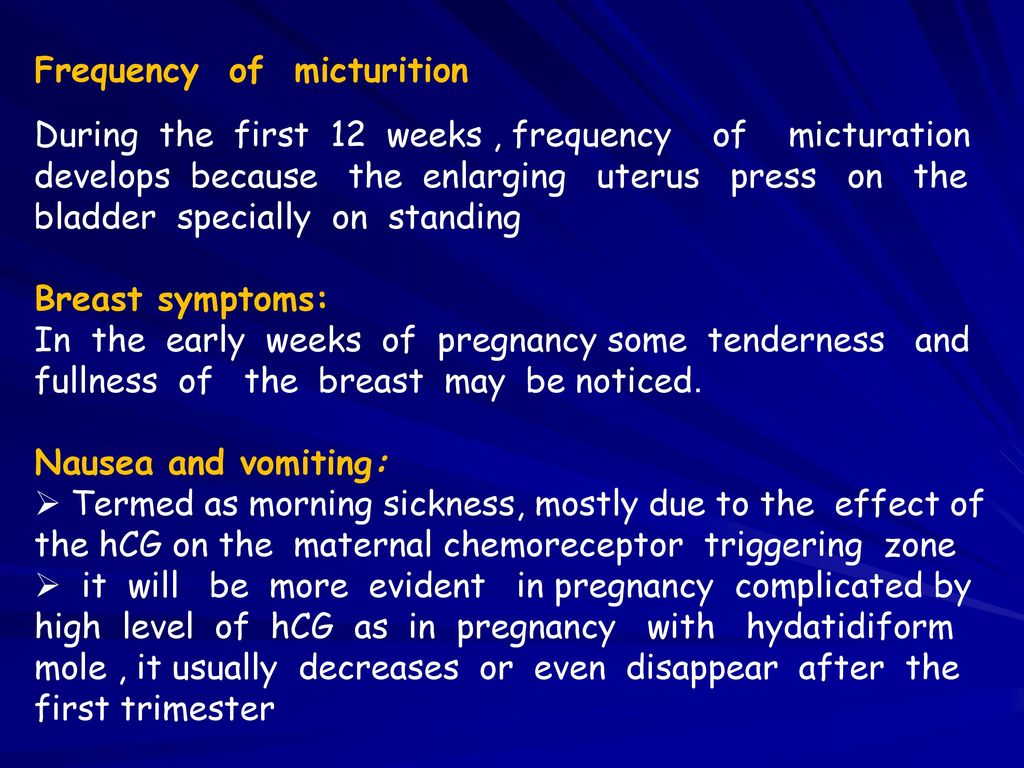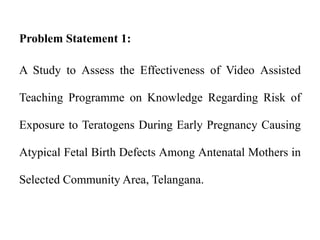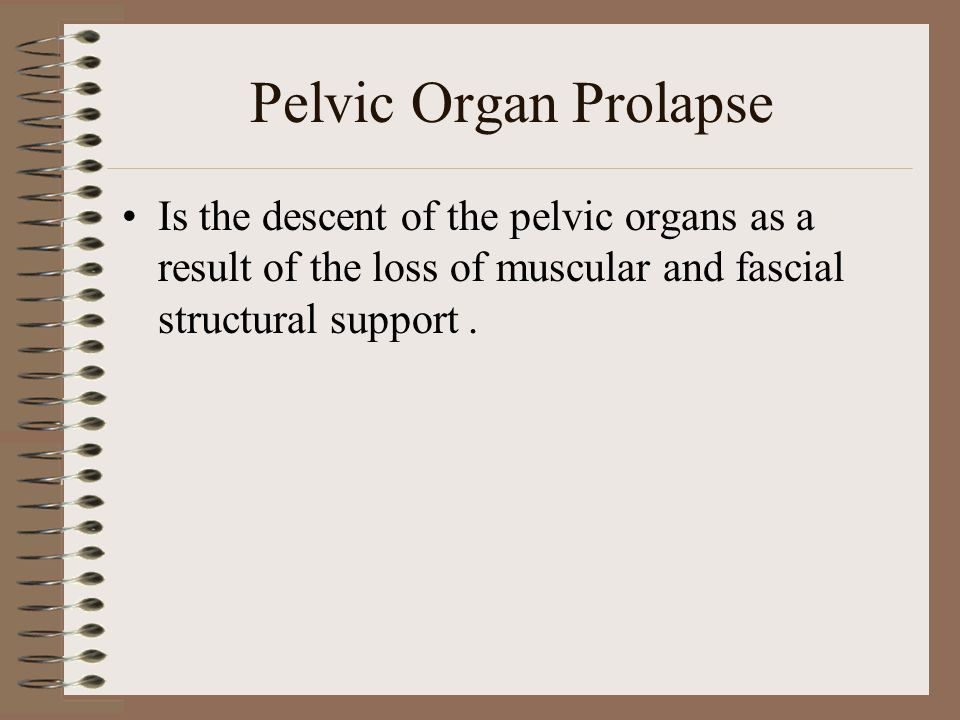Department of Obstetrics & Gynecology - ppt video online download
5 (213) In stock

Symptoms and signs of pregnancy Early symptoms of pregnancy amenorrhea urinary frequency breast engorgement nausea tiredness & easy fatigability abdominal enlargement
Department of Obstetrics & Gynecology
Symptoms and signs of pregnancy. Dr. Dina Nawfal. Department of Obstetrics & Gynecology. College of Medicine. University of Mosul.
Early symptoms of pregnancy. amenorrhea. urinary frequency. breast engorgement. nausea. tiredness & easy fatigability. abdominal enlargement.
Amenorrhea does not have the same significance in case of a woman with irregular period , nor in. a menopausal woman. Pregnancy can occur in a young girl before menarche. & it can arise during a period of amenorrhea, e.g. during lactation or following discontinuation of oral contraception.
During the first 12 weeks , frequency of micturation develops because the enlarging uterus press on the bladder specially on standing. Breast symptoms: In the early weeks of pregnancy some tenderness and fullness of the breast may be noticed. Nausea and vomiting: Termed as morning sickness, mostly due to the effect of the hCG on the maternal chemoreceptor triggering zone. it will be more evident in pregnancy complicated by high level of hCG as in pregnancy with hydatidiform mole , it usually decreases or even disappear after the first trimester.
Due to high estrogen level, low glucose level, low blood pressure. Abdominal enlargement. With the progression of pregnancy the uterine enlargement become evident on abdominal examination ( uterus become palpable abdominally after. 12 week of pregnancy ) sometimes it is first sign that bring the patient to the doctor specially in women with irregular cycle.
diameter so that the uterus becomes globular. Softening of the uterus and cervix. Softening of the uterus due to increase it s vascularity as uterine consistency becomes softer , it may be possible to palpate or to compress the connection between the cervix and fundus. (Hegar’s sign)
Softening and blue discoloration of the cervix soon follow the softening of the uterus and are usually complete by the 16th week. Progressive enlargement of the uterus. By the 12th week the fundus of the uterus is usually palpable in the abdomen just above the symphysis pubis. The fundus reaches the level of the umbilicus at about the 22nd week. Uterus is just below the xiphisternum at the 36 week.
Painless contractions : From early in pregnancy the uterus has an intermittent painless contractions ( Braxton Hicks contractions) it begins usually at 12 weeks gestation.
Ballottement : demonstrated during the bimanual exam. at the 16th to 20th week . Ballottement is when the lower uterine segment or the cervix is tapped by the examiner s finger and left there , the fetus floats upward, then sinks back and a gentle tap is felt on the finger.
Palpation of the fetal parts. Abdominal palpation of fetal parts is usually possible. from the 24th week onwards , and the recognition of. the different fetal part later on is an absolute. sign of pregnancy.
breast changes. primary areola. secondary areola. Montgomery tubercules. Colostrum. Skin changes. Chloasma. linea nigra. striae gravidarum.
These depend on the detection of hCG levels in maternal plasma and its excretion in urine. urine pregnancy test: usually positive on day 35 from the last menstrual period ( 7 days after the last menstrual period ) Serum pregnancy test ; usually positive 7-10 days after conception.
Ultrasonographic recognition of the fetus: By the transvaginal ultrasound. After 5 weeks amenorrhea the gestational sac appear as a small , fluid filled structure . surrounded by echogenic rim of tissue.
After 6th week the Fetal heart activity become evident The trans abdominal us delayed by about 1 week than the trans vaginal us.
In order to calculate the gestational age by this method the woman should. have regular menstrual cycle. Should not be lactating. Not on contraception.
It is frequently seen near or after the menopause , and also in infertile women. There may be amenorrhea , and the woman may declare that she has morning sickness and breast enlargement , and that she can feel fetal movements.
The shape of the swelling is not that of the pregnant uterus , fetal parts cannot be felt and the fetal heart cannot be heard . A pregnancy test or ultrasound scan will be required but the difficulty is to convince the woman that she is not pregnant.

Obstetrics And Gynecology Curriculum - ppt video online download

PPT - Obstetrics/Gynecology PowerPoint Presentation, free download

Obstetrics and Gynecological Emergencies - ppt video online download

Dr J. Woodman Dr C.Gnanachandran - ppt video online download

Program on Obstetrics and Gynecological Update

PPT - The Importance of Population Health in Obstetrics and

Assistant Professor & Consultant Department of Obstetrics & Gynecology - ppt video online download

Department of Obstetrics & Gynecology - ppt video online download

PPT ON Problem Statement.pptx

Dr. Hazem Al-Mandeel 481 GYN Department of Obstetrics & Gynecology - ppt video online download

PPT - JaTeryn Moore PowerPoint Presentation, free download - ID

Department of Obstetric & Gynecology - ppt video online download
Frequent UrinationDuring Pregnancy - Symptoms - Treatment - Mobidoctor
Acupuncture for Frequent Urination
Bladder Bothers: Reasons Behind Frequent Urination in Women
 Canada Post unveils Summit Series stamp to honour Canada 150
Canada Post unveils Summit Series stamp to honour Canada 150 OmicGot High Waisted Yoga Shorts with Pockets for Women Workout
OmicGot High Waisted Yoga Shorts with Pockets for Women Workout Gianvito Rossi Mila Black Suede Ankle Strap D'orsay Pumps - Kate Middleton Shoes - Kate's Closet
Gianvito Rossi Mila Black Suede Ankle Strap D'orsay Pumps - Kate Middleton Shoes - Kate's Closet Skechers Men's Max Cushioning Slip-Ins-Athletic
Skechers Men's Max Cushioning Slip-Ins-Athletic- adidas Powerreact Techfit Women's Plus Size Medium-Support Training Sports Bra
) Buy Women Cotton Bra Panty Set for Lingerie Set ( Pack of 6
Buy Women Cotton Bra Panty Set for Lingerie Set ( Pack of 6
